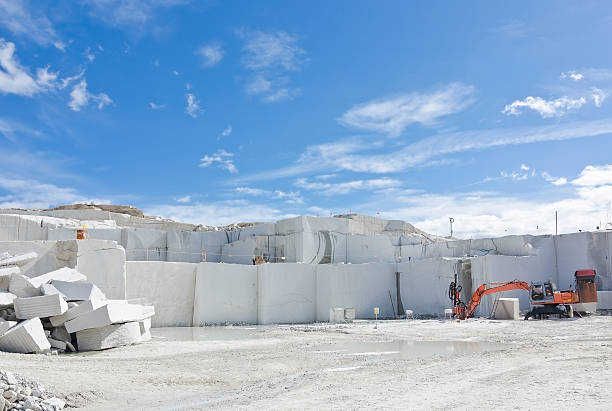The Hidden Treasures: Discovering Granite Quarries in South Africa
The Hidden Treasures: Discovering Granite Quarries in South Africa
Blog Article
Unearthing the Rich History and Sustainable Practices of Granite Quarrying
As we stand on the precipice of discovering the detailed tapestry of granite quarrying, a journey via time reveals not simply the physical act of removing rock however likewise the cultural and historic value woven into the extremely fabric of this practice. From the ancient beginnings that laid the foundation for contemporary quarrying strategies to the sustainable techniques that are shaping the future of this market, each carve mark on granite surface areas narrates waiting to be discovered (granite quarries in south africa). The heritage of granite quarrying stretches much beyond simple extraction; it is a testimony to human resourcefulness, strength, and the enduring appeal of this majestic rock
Old Origins of Granite Quarrying
Dating back to ancient people, the method of quarrying granite has been an important component of human background and building advancement. The earliest proof of granite quarrying days back to old Egypt, where massive pyramids and elaborate sculptures were crafted from this long lasting rock. The Egyptians used primitive devices to remove granite blocks from quarries, showcasing the importance of this material in their monumental buildings.
Relocating forward in background, the Greeks additionally made considerable contributions to the quarrying of granite. The Greeks used granite in different building wonders, such as holy places and sculptures, demonstrating their skill in shaping and sculpting this hardy rock. The Romans further improved the strategies of quarrying granite, using innovative tools like chisels and hammers to extract and form granite for their legendary frameworks.
Through the centuries, the practice of quarrying granite has evolved, with modern-day technologies improving effectiveness while preserving the ageless appeal of this natural stone - granite quarries in south africa. From ancient human beings to modern home builders, the heritage of granite quarrying remains to shape our world
Evolution of Quarrying Strategies
The evolution of quarrying methods has actually been marked by a continual development towards greater performance and precision in drawing out granite. Early quarrying techniques involved hands-on labor with fundamental devices such as chisels, hammers, and wedges to draw out granite blocks from the earth.
In even more recent times, the arrival of equipment changed the quarrying market, allowing quicker removal prices and enhanced performance. Technologies such as ruby wire saws, high-pressure water jets, and pneumatically-driven drills have ended up being standard in modern-day quarries, permitting for precise cutting and reduced waste. Improvements in computer-controlled equipment and 3D modeling have maximized quarrying procedures, leading to minimal ecological impact and boosted sustainability practices. As the need for granite remains to rise, the development of quarrying methods continues to be important to conference sector requires effectively and sustainably.
Social Value of Granite
Granite holds an extensive social significance across various people due to its long-lasting visibility in architectural work of arts and admired monuments. From the marvelous pyramids of Egypt to the detailed carvings of the Angkor Wat holy place in Cambodia, granite has been a product of option for expressing magnificence and durability in cultural This Site heritage. In ancient Rome, granite columns adorned temples and public structures, symbolizing toughness and durability. The social value of granite expands past its physical qualities; it personifies durability, security, and timelessness, making it a sign of enduring legacies and customs.

Lasting Practices in Quarrying
Among the abundant background of granite quarrying and its cultural importance exists an expanding emphasis on lasting techniques within the sector. As environmental awareness and problems regarding resource depletion have enhanced around the world, the quarrying market has increasingly embraced sustainable methods to reduce its effect on the setting and surrounding areas.

Moreover, improvement and rehab of quarry sites post-extraction are essential to sustainable methods. By bring back quarried areas to a natural or advantageous state, such as producing wildlife habitats or entertainment rooms, quarriers can counter the ecological impact of their operations and contribute positively to the local environment.
Tradition of Granite Quarrying
With a historical backdrop soaked in craftsmanship and industrial development, what withstanding influence has granite quarrying left on the landscape of modern-day society? The tradition of granite quarrying goes beyond simple extraction techniques; it has actually formed architectural marvels, city landscapes, and social heritage worldwide. The long lasting nature of granite has made it a recommended selection for monoliths, buildings, and infrastructure, standing as a testimony to the skill and artistry of quarry employees across generations.
Additionally, the financial footprint of granite quarrying can not be forgotten. The market remains to give employment possibility and drive regional economic situations in regions where granite extraction is prevalent. It has actually also stimulated technical improvements in quarrying methods and tools, resulting in a lot more efficient and lasting methods.
In terms of sustainability, the tradition of granite quarrying includes efforts to alleviate environmental impacts with recovery tasks and accountable check source monitoring. By balancing economic rate of interests with ecological stewardship, the industry makes every effort to ensure that future generations can continue to take advantage of this long-lasting natural deposit.
Final Thought

Report this page